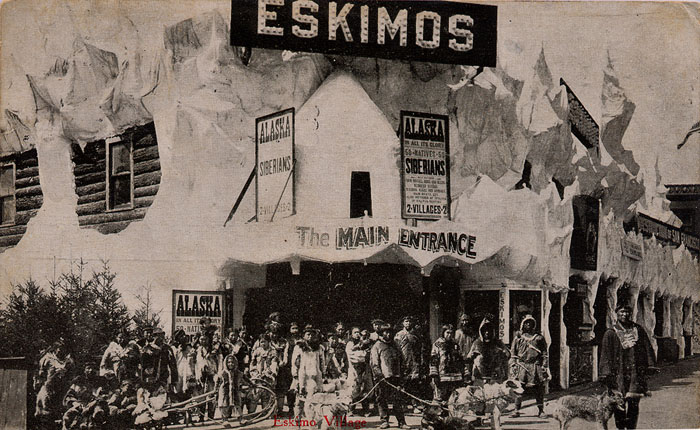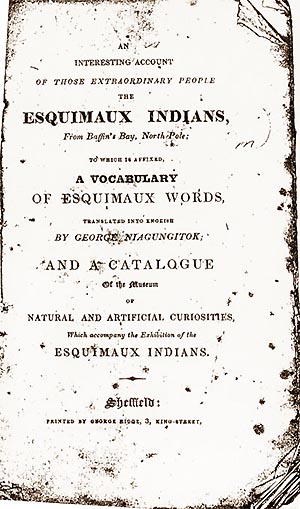
'Esquimaux' on
Display
At many times in
the past two centuries, Inuit and Inupiat peoples have been
brought to European and American cities for display. The images
on this page tell something of the history of these kinds of
displays.

In 1824, enterprising whaleboat
captain Samuel Hadlock brought two "Esquimaux" from
Baffin Island and displayed them along with a variety of polar
artifacts at the Egyptian Hall, Picadilly, London. His pamphlet
was full of misinformation, and the actual display mingled north
and south with a series of unrelated artifacts, such as the
"skin of a Zealand warrior." The show was not much of a
success in London, but Hadlock carried on to the Continent,
despite the death of the female Inuk (she was replaced by a
series of women whose features Hadlock calculated could pass as
"Eskimo"). Hadlock eventually married a young woman he
met in Germany, and when the lone surviving Inuk in his care
died, returned to Maine. He was killed not long after in a
whaling accident off the coast of Newfoundland.
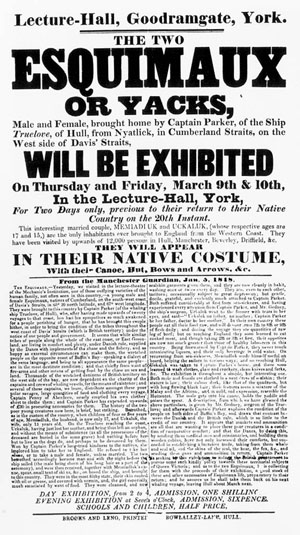
In 1847, Captain
John Parker brought an Eskimo couple from Cumberland Sound to the
whaling port of Hull, England aboard his ship the 'Truelove.'
Ostensibly brought to England to raise awareness of poor
conditions in their homeland, the couple, Memiadluk and Uckaluk,
were treated rather better than other such human zoo exhibits;
Captain Parker placed them in the care of his ship's surgeon, who
innoculated them for smallpox upon their arrival in England.
Nonetheless, they were put on display in the Public Rooms
beginning on 2 December, dressed in their sealskin clothes. They
also appeared at the Mechanics Institute in Manchester, as well
as at the lecture hall in Goodramgate, York (from which the above
handbill survives).
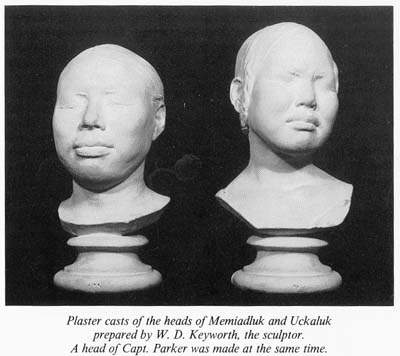
from Arthur Credland, The Hull Whaling Trade: An Arctic Enterprise
The casts of Memiadluk and Uckaluk
shown above were made shortly before their departure. Just as the
couple sailed from Stromness in 1848, there was an outbreak of
measles on board the ship; Uckaluk died, but Memiadluk was nursed
back to health, and returned to his home with a large pile of
gifts from his hosts.
(From the Illustrated London News, collection of Russell A. Potter) This engraving shows three Inuit -- "Tookoolito" (right), "Ebierbing" (left) and the boy "Haralukjoe" (far left), who were brought to England in 1853 by Thomas Bowlby, where they met with Queen Victoria at Windsor Castle. As fate would have it, the first two, later known as "Hannah" and "Joe," would have an extensive career ans guides and interpreters, working with Charles Francis Hall in his search for Franklin, as well as on the U.S. Polaris Expedition led by Hall. Indeed, Hall brought them with him on his American lecture tour of the mid-1860's, which was designed to raise money for his return to the Arctic; it is clear from the handbills that they were, in fact, the main attraction of these lectures:

In addition to bringing Ebierbing and Tookoolito with him to his lectures, Hall on two occasions "loaned" them out for display -- once to Cotting and Guay's Aquarial Gardens in Boston, and once to Barnum's American Museum in New York:
From the collection of Russell A. Potter -- New York Times, Nov. 20, 1862.
This card
advertised the Eskimo pavillion at the Pan-American Exposition in
Buffalo, NY in 1901. The Inuit at this pavillion demonstrated
their skill with the whip, and gave demonstrations of driving
sled-dogs as well as the "Esquimaux game of leap-frog."
Thomas Edison made silent films of this exhibit, which can be
viewed at the American Memory pages at the Library of Congress.
From the collection of
Russell A. Potter
The item below is a
playing card sold at the Alaska-Yukon-Pacific Exhibition. By
showing Inupiat in various stages of western dress under the
title "Evolution," this card makes it quite clear that
Westernization was the way to go.
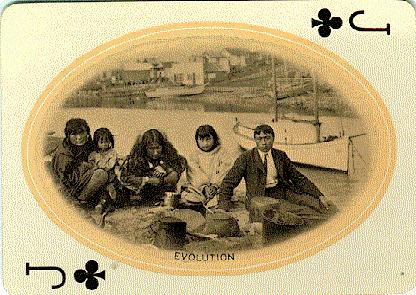
This image shows an
Eskimo pavillion at the St. Louis World's fair. Like the
pavillion built in Buffalo in 1901, this exhibit centered around
an ersatz Arctic village complete with igloos and glaciers, and
generally catered to every stereotype of the Arctic in the minds
of fairgoers.
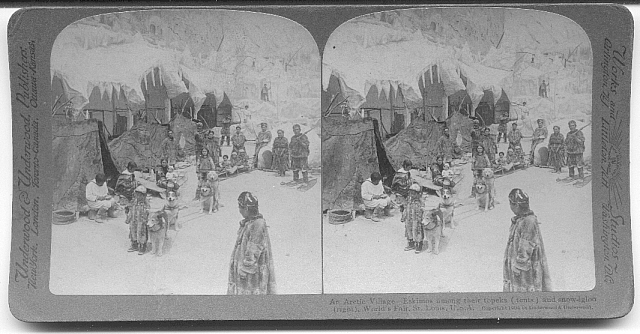
The "Eskimo Village" at the Alaska-Yukon Pacific Exposition in 1909. The caption on the back of the card reads as follows: "ESKIMO VILLAGE: In the Eskimo Village there are Eskimos from Labardor, Siberia, and Alaska, and visitors have the opportunity to study the various tribes. The Eskimo Village is one of the largest attractions on the Pay Streak."
